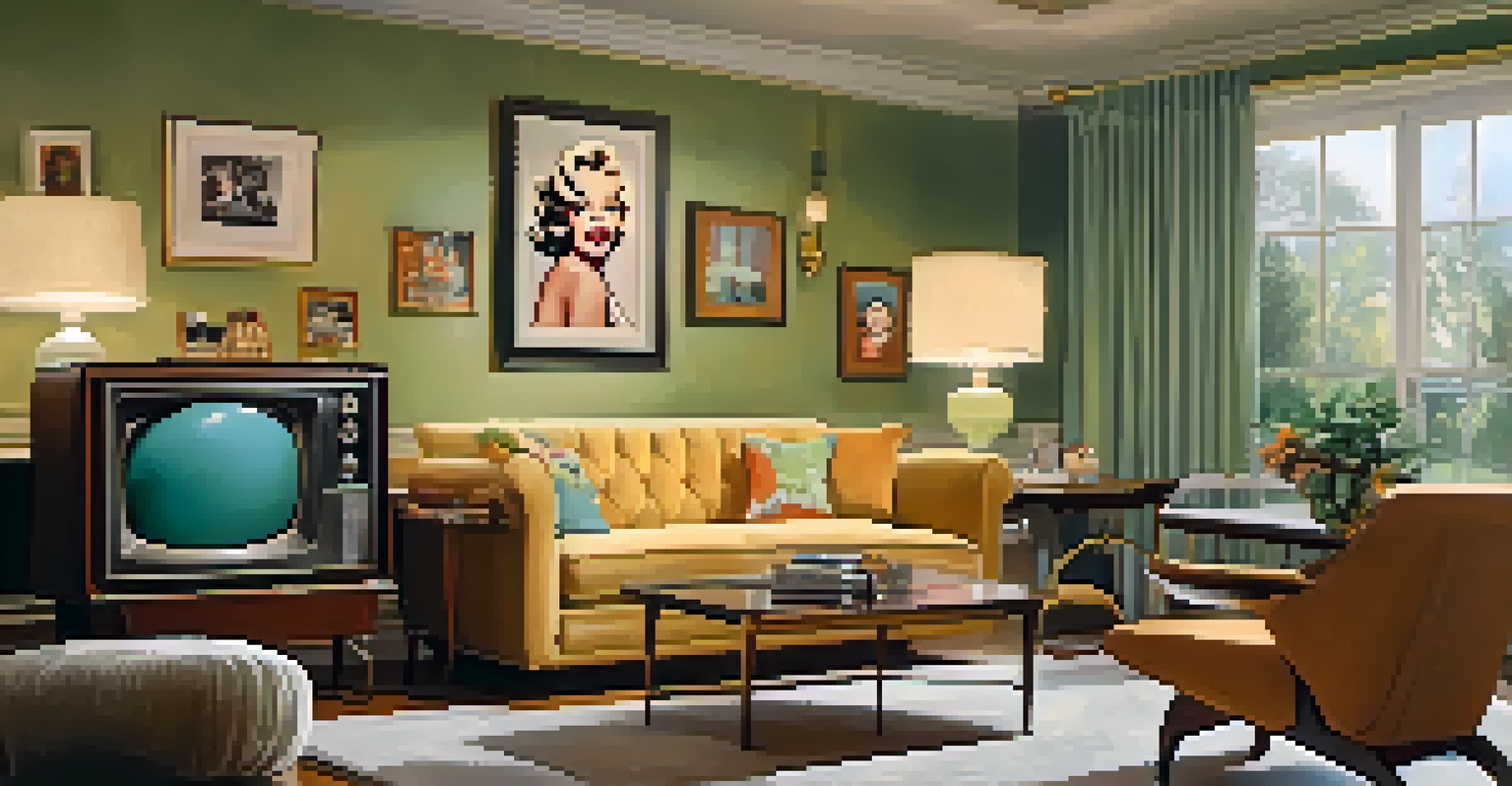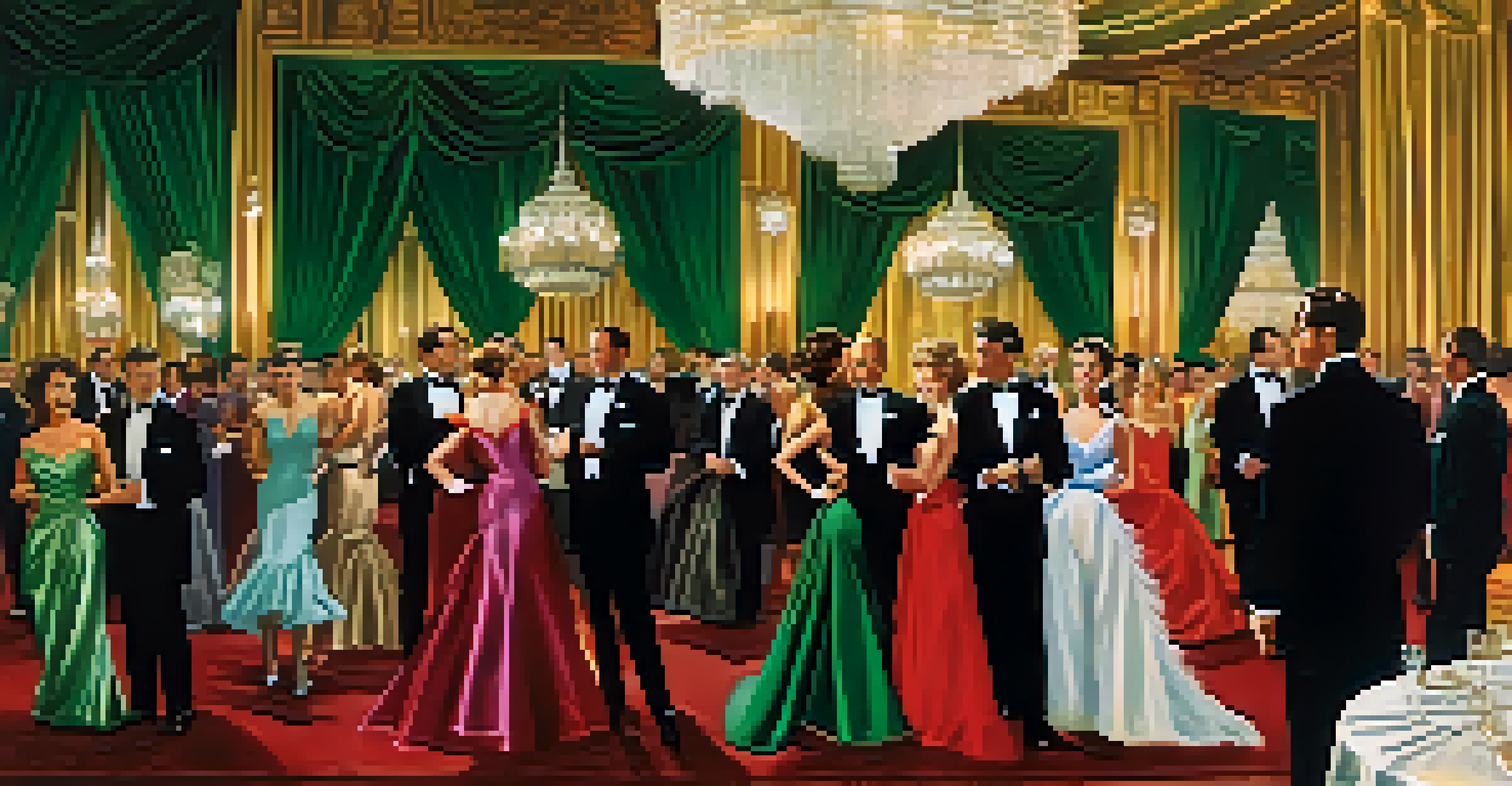The Golden Age of Hollywood: A Cultural Milestone in Cinema

Introduction to Hollywood's Golden Age: A Brief Overview
The Golden Age of Hollywood, spanning from the late 1920s to the early 1960s, marked a transformative period in cinema. During this time, the film industry flourished, producing timeless classics that still resonate today. The introduction of sound films, or 'talkies,' in the late 1920s changed the landscape, captivating audiences across the globe.
Cinema is a matter of what's in the frame and what's out.
This era was characterized by the emergence of major film studios, like MGM, Paramount, and Warner Bros., which dominated the industry. These studios created a star system that not only launched the careers of iconic actors and actresses but also shaped public perception of celebrity. The glitz and glamour of Hollywood became synonymous with the American Dream, drawing countless aspiring talents to the West Coast.
As we delve deeper into this remarkable period, it’s essential to understand how the Golden Age laid the groundwork for modern filmmaking and storytelling techniques. From the rise of genres to the establishment of cinematic conventions, this era served as a cultural touchstone that continues to influence filmmakers today.
Key Innovations: The Birth of Sound and Color in Film
One of the most significant innovations of the Golden Age was the introduction of synchronized sound, heralded by the 1927 film 'The Jazz Singer.' This shift from silent films to 'talkies' revolutionized the way stories were told, allowing for more dynamic performances and emotional connections with audiences. Suddenly, dialogue could enhance character development and engage viewers on a deeper level.

In addition to sound, the use of Technicolor transformed the visual experience of films. Movies like 'The Wizard of Oz' and 'Gone with the Wind' showcased vibrant colors that brought stories to life in ways that black-and-white films could not. This technical advancement not only captivated audiences but also inspired filmmakers to experiment with visual storytelling.
Hollywood's Golden Age Innovations
The introduction of sound and Technicolor revolutionized filmmaking, enhancing storytelling and audience engagement.
These innovations set the stage for what we consider modern cinema, illustrating how technology can enhance artistic expression. As filmmakers embraced these tools, they expanded the boundaries of creativity, making the magic of Hollywood more accessible and engaging.
Iconic Films That Defined the Golden Age
The Golden Age of Hollywood produced a plethora of iconic films that have stood the test of time. Classics like 'Casablanca,' 'Citizen Kane,' and 'It's a Wonderful Life' are not just entertainment; they are cultural artifacts that reflect the values and struggles of their respective eras. Each film offers a unique glimpse into the human experience, often tackling themes of love, sacrifice, and redemption.
The greatest thing you can do is surprise yourself to death.
These films were not merely products of their time but rather shaped societal norms and influenced generations. For instance, 'Gone with the Wind' addressed complex issues of race and identity, prompting conversations that continue to this day. Such films became touchstones for audiences, creating shared experiences that transcended cultural boundaries.
Moreover, the storytelling techniques and cinematic styles pioneered during this time laid the foundation for future filmmakers. The impact of these films on both the industry and society at large is a testament to their enduring relevance, reminding us of the power of cinema to reflect and shape cultural narratives.
The Star System: Rise of Hollywood Icons
Hollywood's Golden Age also saw the rise of the star system, where actors and actresses became household names. Icons like Marilyn Monroe, Humphrey Bogart, and Audrey Hepburn not only dazzled audiences with their performances but also became symbols of their time. Their larger-than-life personas contributed to the allure of Hollywood, making it a dream destination for many seeking fame.
Studios played a crucial role in crafting these stars' images, using marketing strategies to create an aura of glamour and intrigue. This manipulation of public perception often blurred the lines between reality and fantasy, as fans became enamored with the lives of their favorite stars. The impact of this star system can still be seen today in how celebrities are marketed and consumed.
Iconic Films Shaping Culture
Timeless classics from this era reflect societal values and continue to influence contemporary narratives.
The fascination with these icons transcended the silver screen, influencing fashion, culture, and even politics. As we reflect on this period, it's clear that the star system was not just about entertainment; it was a cultural phenomenon that shaped societal ideals and aspirations.
Cinematic Genres: Defining Styles of the Golden Age
The Golden Age of Hollywood was instrumental in establishing various cinematic genres that continue to thrive today. Genres like film noir, musicals, and romantic comedies emerged during this period, each offering unique storytelling techniques and stylistic elements. For example, film noir introduced a darker, grittier aesthetic that captivated audiences with its complex characters and moral ambiguity.
Musicals, on the other hand, brought joy and escapism to viewers, combining catchy songs with dazzling choreography. Films like 'Singin' in the Rain' showcased the artistry of performance, demonstrating how music and dance could elevate storytelling. These genres not only entertained but also reflected the cultural zeitgeist of the time.
The establishment of these genres allowed filmmakers to explore diverse narratives and themes, making cinema a mirror to society. As we examine the legacy of the Golden Age, it's evident that these genres continue to influence contemporary filmmakers, serving as a foundation for new stories and storytelling methods.
Cultural Impact: Hollywood's Role in Society
The Golden Age of Hollywood had a profound cultural impact, shaping societal norms and values in various ways. Films often addressed pressing social issues, such as war, poverty, and civil rights, reflecting the concerns of the American public. For instance, movies like 'The Grapes of Wrath' highlighted the struggles of the Great Depression, prompting audiences to empathize with those less fortunate.
Moreover, Hollywood became a platform for escapism, providing audiences with a sense of hope during challenging times. The glitz and glamour of Hollywood offered a contrast to the realities of everyday life, allowing viewers to dream and aspire. This dual role of cinema as both a reflection and an escape is a hallmark of the Golden Age.
The Enduring Star System
The star system established during this period created cultural icons whose influence persists in today's celebrity culture.
As we consider the legacy of this era, it's important to recognize how Hollywood's narratives shaped cultural attitudes and influenced public discourse. The films produced during this time not only entertained but also challenged audiences to think critically about the world around them.
The Legacy of Hollywood's Golden Age: Influences Today
The legacy of the Golden Age of Hollywood continues to influence modern cinema, with filmmakers drawing inspiration from its storytelling techniques, genres, and iconic performances. Today’s movies often pay homage to the classics, whether through remakes, adaptations, or stylistic nods. The themes explored during this era—love, sacrifice, and the human condition—remain relevant, echoing through contemporary narratives.
Moreover, the star system established during the Golden Age persists, as celebrities maintain their status as cultural icons. The fascination with Hollywood stars continues to shape public perception and consumer behavior, highlighting the enduring power of celebrity culture. As social media amplifies this phenomenon, today's stars often mirror the larger-than-life figures of the past.

In essence, the Golden Age of Hollywood serves as a foundation upon which modern cinema is built. Its influence is evident not only in the films we watch but also in how we perceive storytelling and celebrity, reminding us of the lasting impact of this remarkable era.